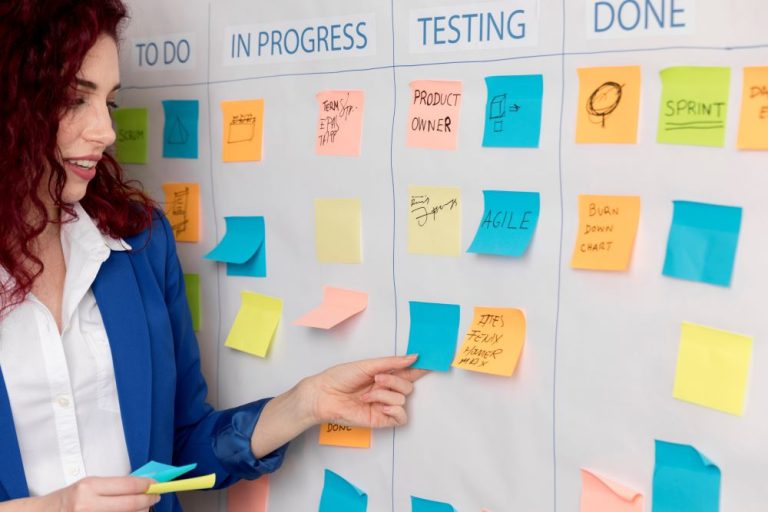The meaning and use of Agile information radiators
Information radiators play an important role in the life of agile teams, as they ensure that all team members have access to the latest information on developments and project progress, facilitating transparency and effective communication. In this article, we'll take a look at what you need to know about dashboards, discussing their role and benefits.

What are the information radiators?
The term information radiator is attributed to Alistair Cockburn, one of the signatories of the Agile Manifesto. Also known as the Big Visible Chart (BVC), it comprises handwritten, drawn, printed or electronic displays, boards that quickly and easily inform stakeholders about a particular development or piece of work.
The information boards are usually placed in a central location so that team members can be immediately informed of the latest information, such as the number of automated tests, incident reports, integration status, etc.
Think of it like a notice board in a school hall. It is always placed in a place where there are typically many people, so students and teachers are more likely to see important announcements. Similarly, information boards will highlight key information to Agile team members, project stakeholders and other interested parties.
They are not static, but are constantly updated as the project progresses.

Kanban board vs. Scrum board
A Kanban board is perhaps the best-known example of an information board. It places cards or sticky note cards in separate columns, tracking the progress of the project. For example, the column on the left could be 'Planned', the middle 'In Progress' and the right 'Completed', but of course it is best to break the whole process down into individual stages most specific to the development. The Kanban table also contains so-called WIP limits, which define the maximum number of tasks and elements in a workflow.
Scrum boards have a similar layout, the only difference is that they have tasks scheduled for a specific time interval, they work in sprints, and the boards are shaped accordingly and WIP limits are not necessary.
The role of agile information boards
Information boards can be a good motivational tool for agile teams. Although information is now ubiquitously available digitally, these physical visual boards are a great way to visualise important data and show progress from a bird's eye view, which is very inspiring for project participants.
This way, team members don't need to check everything online, search for information, they can simply glance at the whiteboard to know exactly where they are in the project.
The advantages of information radiators
Now let's look at why you should use information boards!
Easily accessible information
The information radiators act as a central hub for all the important data of a development team, displaying it in an easy-to-understand visual format. This allows developers, managers and other stakeholders to access information instantly and easily, whenever they need it.
Greater focus
The information radiators help agile teams to prioritise tasks correctly on the Kanban or Scrum board. This makes it easier to understand current priorities and supports team members to focus on the most important tasks.
Better communication
Information boards can be an effective way of promoting open communication within the team and encouraging feedback. They allow all team members to share progress in a public space using visual tools, which can make communication more centralised and effective.
Transparency
A key benefit is that the information board provides transparency for the team and stakeholders. Team members remain accountable, progress is visible and managers can oversee all aspects of the development process.
Checking the health of the team
Regular monitoring of the team's health (workload, number of tasks, capacity review) will help identify problems that could otherwise slow down the project and cause burnout in the longer term.
Motivation
If a development team cannot see the results achieved, it can lead to a lack of motivation. Information boards provide a simple visual representation of the team's progress that is highly inspiring and motivating to achieve goals.

Information radiators in scrum: a more effective retrospective
In agile teams, the previous sprint is evaluated in the retrospective. These are essential for agile teams and any organisation seeking to improve workflow.
Gathering accurate information on all topics is essential to ensure that Retrospective feed back what has been said in the discussions. The sprints can vary in length, but it is often a challenge to remember everything that happened during that time. Scrum retrospectives that do not rely on information boards that record events, feedback, ideas and comments during the sprint tend to focus on the last few days, and so much of the benefit is lost.
How do we use agile information radiators?
To really get the full benefit of information boards, keep the following in mind!
Precise information
Care must be taken to ensure that information boards are accurate and always display up-to-date information.
Continuous updates
Information is only relevant if it is constantly updated. In some teams, all members are free to share information. In others, there may be certain rules about communicating new information. For example, in agile teams, updates are often made after the daily meeting.
Simplicity and readability
Information boards should be legible and easy to understand at a glance. If they are too complex, they will not achieve their purpose. In order to increase efficiency and clarity, attention should be drawn, for example with colourful stickers or notepads.
Easy accessibility
All team members and interested parties should have access to the latest version of the information board wherever they are. This is relatively easy if the team is located in an office or building, as the visual platform is then located in a central place. For remote teams, this needs to be done in digital form.
How to make an information radiator?
The following steps can help you create an effective visual interface!
1. Think about the goal, Choose a style!
First of all, it is important to decide what information you want to share through this platform and what kind of platform you want it to be. Will it be digital or physical?
It is worth designing it so that it is easy to update and does not require major moderation. A digital display can be used as a whiteboard if the team uses an application that has these capabilities. If we create a digital form, we need to ensure that there is a large screen in a central location for display and that all team members can easily update their status.
Next, choose an efficient way to format the taskbars. If the team is using a scrum framework, a scrum board or sprint burn-down chart is the best way to track progress. A Kanban board can also be used if it is more adapted to the team's workflow. If you don't want to use either method, you can simply create a task list and a board with the processes.
2. Prepare the information radiator!
Once you have the format, it's time to create the board! For the physical display, many companies use a series of large whiteboards divided into columns and rows, larger notecards or sticky post-its to record the team's tasks. It can be useful to use different coloured cards for different categories or processes. Always place the board in a place where everyone can see it.
If a digital display is used, it can be created using the team's project management application. Many of these platforms allow professionals to create Kanban or Scrum style boards. Care should also be taken to ensure that all team members can access and update the status of their tasks. It may be useful to display the board in the office using a large screen or projector.
3. Colour it with a calendar, diagrams, graphs!
It is important that the signs contain visualisation elements in addition to dry information. You may even want to add a calendar, which can visualise the roadmap, for example.
This may even include a list of obstacles that the team will face. This will make everyone aware of the potential challenges and can be an incentive for problem solving.
Other elements could include test tracking, incident reports and progress graphs.
4. Train the team!
Once the information board is ready, it is important that everyone knows how to use it. It is worth organising a short internal information session where team members can learn how to use the whiteboard.
Do you want to develop your agile toolkit? Get international qualifications! Deepen your knowledge with our professional trainings!

 Designabc
Designabc